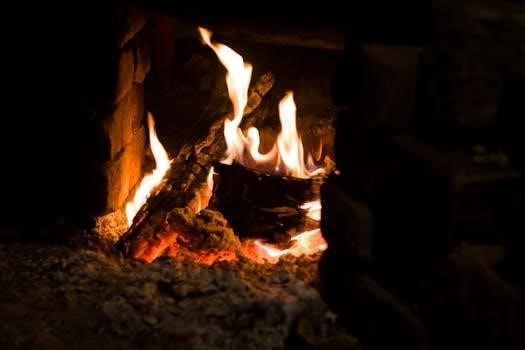Celsius to Fahrenheit Conversion Table PDF⁚ A Comprehensive Guide
Embark on a journey of temperature mastery with our comprehensive guide to Celsius to Fahrenheit conversion tables in PDF format. These tables offer a convenient and reliable resource for quickly converting temperatures between the Celsius and Fahrenheit scales.
Temperature, a fundamental aspect of our environment, is measured using various scales, with Celsius and Fahrenheit being the most prevalent. Understanding these scales and how to convert between them is essential in various fields, from everyday cooking to scientific research. Celsius, also known as centigrade, is a metric scale where water freezes at 0 degrees and boils at 100 degrees. It’s widely used in most countries for general-purpose temperature measurement.
Fahrenheit, on the other hand, is primarily used in the United States. On the Fahrenheit scale, water freezes at 32 degrees and boils at 212 degrees. While seemingly arbitrary, these numbers have historical roots.
The need to convert between Celsius and Fahrenheit arises due to the global exchange of information and products. Recipes, weather forecasts, and scientific data often use different scales, requiring conversion for accurate interpretation. This is where Celsius to Fahrenheit conversion tables become invaluable tools.
Understanding the Celsius Scale
The Celsius scale, a cornerstone of the metric system, is defined by two key reference points⁚ the freezing point of water at 0°C and the boiling point of water at 100°C under standard atmospheric pressure. This straightforward system makes it intuitive for understanding temperature changes in relation to water, a substance crucial for life. Developed by Swedish astronomer Anders Celsius, this scale offers a decimal-based approach, simplifying calculations and making it widely adopted in scientific research and everyday applications across most of the world.
The Celsius scale is incremented uniformly between these points, dividing the range into 100 equal degrees. Each degree Celsius represents 1/100th of the difference between the freezing and boiling points of water. This uniform division enables precise measurements and facilitates easy temperature comparisons.
From weather forecasts to cooking recipes, the Celsius scale plays a vital role in daily life. Understanding its fundamental characteristics empowers individuals to interpret temperature information accurately and make informed decisions. Its adoption in scientific fields ensures consistency and ease of collaboration among researchers.
Understanding the Fahrenheit Scale
The Fahrenheit scale, primarily used in the United States, sets its reference points differently from Celsius. Water freezes at 32°F and boils at 212°F. Developed by German physicist Daniel Gabriel Fahrenheit, this scale initially used a brine solution as its zero point, aiming to avoid negative values in commonly encountered temperatures. The interval between freezing and boiling is divided into 180 degrees.
While less intuitive for water-related phenomena compared to Celsius, Fahrenheit remains significant due to its widespread use in certain regions. It’s crucial for those living in or interacting with the United States to comprehend Fahrenheit for everyday tasks like checking weather reports or adjusting thermostats.
The Fahrenheit scale’s seemingly arbitrary reference points can be traced back to its historical context and the materials available to Fahrenheit during its creation. Although the scientific community largely favors Celsius for its decimal-based simplicity, understanding Fahrenheit is essential for navigating temperature-related information in specific cultural and geographical contexts.
The Importance of Temperature Conversion Tables
Temperature conversion tables are invaluable tools that bridge the gap between Celsius and Fahrenheit scales. These tables offer a quick and reliable way to translate temperature values, eliminating the need for manual calculations and reducing the risk of errors. In a world where both scales are prevalent, conversion tables provide a convenient reference point for various applications.

Whether you’re a student tackling science homework, a chef adapting recipes from different countries, or a traveler navigating unfamiliar climates, temperature conversion tables offer immediate assistance. They enable seamless understanding and comparison of temperature data, regardless of the scale used.
The importance of these tables extends beyond personal use. Industries such as meteorology, engineering, and manufacturing rely on accurate temperature conversions for critical decision-making. Conversion tables ensure consistent and reliable data interpretation, preventing costly mistakes and promoting efficient operations. The ability to quickly convert temperatures fosters clear communication and collaboration across diverse fields.
Celsius to Fahrenheit Conversion Formula
The Celsius to Fahrenheit conversion formula serves as the mathematical foundation for accurately translating temperatures between the two scales. Understanding this formula empowers individuals to perform conversions manually, providing a deeper understanding of the relationship between Celsius and Fahrenheit.
The formula is expressed as⁚ F = (C × 9/5) + 32, where ‘F’ represents the temperature in Fahrenheit and ‘C’ represents the temperature in Celsius. This equation involves multiplying the Celsius temperature by 9/5 (or 1.8) and then adding 32 to the result. This process effectively scales and shifts the Celsius value to its corresponding Fahrenheit equivalent.
The formula reveals that the Fahrenheit scale is a linear transformation of the Celsius scale. The multiplication by 9/5 adjusts the size of the degree, while the addition of 32 establishes the zero point. By grasping this mathematical relationship, users can confidently convert temperatures and gain a more intuitive understanding of temperature measurements in different units. This understanding complements the use of conversion tables, offering a versatile approach to temperature conversion.
Creating a Celsius to Fahrenheit Conversion Table
Constructing your own Celsius to Fahrenheit conversion table provides a hands-on approach to understanding temperature conversions. This process involves applying the conversion formula across a range of Celsius values and organizing the results in a clear, tabular format.
Begin by selecting a range of Celsius temperatures that you wish to include in the table. Determine the increment between each Celsius value, such as 1 degree, 5 degrees, or 10 degrees. Using the formula F = (C × 9/5) + 32, calculate the corresponding Fahrenheit temperature for each Celsius value. Record both the Celsius and Fahrenheit temperatures in a table with two columns.
Ensure the table is organized and easy to read. Consider using spreadsheet software or a word processor to create the table. Formatting options can enhance readability, such as using alternating row colors or borders. Once completed, the table can be saved as a PDF for convenient access and sharing. Creating a conversion table not only reinforces your understanding of the conversion process but also provides a valuable reference tool for future use.
Using a Celsius to Fahrenheit Conversion Chart PDF
A Celsius to Fahrenheit conversion chart PDF offers a quick and convenient way to find equivalent temperatures without manual calculations. To effectively use such a chart, first identify the temperature you wish to convert, whether it’s in Celsius or Fahrenheit. Locate the column corresponding to your starting unit on the chart.
Then, find the specific temperature value within that column. Once you’ve located the starting temperature, trace across the row to the adjacent column, which displays the equivalent temperature in the other unit. For example, if you want to convert 25°C to Fahrenheit, find 25 in the Celsius column and read the corresponding value in the Fahrenheit column.
These charts are invaluable for cooking, scientific research, and everyday situations where quick temperature conversions are needed. Keep a printed copy handy or store the PDF on your devices for instant access. Remember that some charts may have limited ranges or increments, so choose one that suits your specific needs. With a conversion chart PDF, temperature conversions become effortless.

Common Temperature Conversions
Certain temperature conversions frequently arise in daily life and various applications. One of the most common is converting the freezing point of water, 0° Celsius, which equates to 32° Fahrenheit. Similarly, the boiling point of water, 100° Celsius, is equivalent to 212° Fahrenheit. These two points serve as essential benchmarks for understanding temperature scales.
Another frequently encountered conversion is the average human body temperature, typically around 37° Celsius, which corresponds to 98.6° Fahrenheit. In weather reports, temperatures around 20° to 30° Celsius are often discussed, translating to approximately 68° to 86° Fahrenheit. These ranges are crucial for planning outdoor activities and understanding climate conditions.
Cooking recipes also frequently use specific temperatures, such as 180° Celsius (356° Fahrenheit) for baking or 160° Celsius (320° Fahrenheit) for slow cooking. Knowing these common conversions allows for seamless adaptation of recipes from different regions. By familiarizing yourself with these key temperature equivalents, you can confidently navigate various situations requiring temperature knowledge.
Applications of Celsius to Fahrenheit Conversion Tables
Celsius to Fahrenheit conversion tables find widespread use across various fields, offering a quick and reliable means of temperature translation. In the culinary world, these tables are invaluable for adapting recipes that use different temperature scales. Chefs and home cooks alike can easily convert oven temperatures or cooking temperatures for ingredients, ensuring accurate and consistent results.
Scientific research and engineering also heavily rely on these conversion tables. Researchers often need to convert data recorded in one scale to another for analysis or comparison purposes. Engineers use them to ensure accurate temperature control in various systems and processes.
Medical professionals utilize conversion tables for accurate patient care. When taking a patient’s temperature, it may be necessary to convert between Celsius and Fahrenheit depending on the equipment available. This is essential for diagnosis and treatment. Weather forecasting is another area where quick conversions are critical. Presenters can use temperature conversion tables when reporting on local weather conditions to accurately convey the temperature in both Fahrenheit and Celsius. These examples illustrate the vital role these conversion tables play in ensuring accuracy and efficiency.
Advantages of Using a PDF Conversion Table
Opting for a Celsius to Fahrenheit conversion table in PDF format offers several distinct advantages over other methods. First and foremost, PDFs are universally accessible and can be opened on virtually any device, regardless of the operating system or installed software. This ensures that the conversion table is readily available whenever and wherever it’s needed, whether on a computer, tablet, or smartphone.
PDFs also maintain formatting integrity, meaning the table will appear exactly as intended, without any distortion or misalignment. This is crucial for ensuring accurate and reliable conversions. Furthermore, PDF conversion tables are easily printable, allowing users to create a hard copy for quick reference in situations where electronic devices are not convenient or permitted.

Another advantage is the ability to store multiple conversion tables within a single PDF document. This can be particularly useful for accessing different temperature ranges or levels of precision. Finally, PDF files are generally small in size, making them easy to share and store without consuming excessive storage space. These benefits make PDF conversion tables a practical choice for users seeking a convenient, reliable, and accessible temperature conversion solution.
Where to Find Reliable Conversion Tables
Finding reliable Celsius to Fahrenheit conversion tables is crucial for ensuring accuracy in your temperature conversions. A great place to start your search is with reputable scientific and educational websites. These sites often provide meticulously crafted tables, backed by accurate data and reviewed for precision. Look for sources affiliated with universities, research institutions, or meteorological organizations.
Another avenue for finding trustworthy conversion tables is through established engineering and technical resources. Many handbooks and online databases cater to professionals who rely on precise temperature measurements. These resources typically offer comprehensive tables that are regularly updated and validated.
When downloading a PDF conversion table from the internet, always check the source’s credibility. Be wary of websites with unprofessional designs or those that lack clear contact information. It’s also wise to compare the values in a downloaded table with those from a known reliable source to ensure consistency and accuracy. Always prioritize sources that clearly state their methodology and data sources for added assurance.
Tips for Accurate Temperature Conversions
Achieving accurate temperature conversions between Celsius and Fahrenheit requires attention to detail and a consistent approach. Start by ensuring that you are using a reliable conversion table or formula. Double-check the source of your information and verify its accuracy against multiple sources if possible. When using a physical conversion table, make sure it is clean and undamaged to avoid misreading values.

For manual calculations, use the correct formula⁚ Fahrenheit equals Celsius multiplied by 9/5, plus 32. Alternatively, Celsius equals Fahrenheit minus 32, multiplied by 5/9. Pay close attention to the order of operations to avoid errors. When dealing with negative temperatures, be especially careful with your calculations.
Consider using a reliable online converter or calculator as a quick way to verify your results. These tools can help catch mistakes and provide an additional layer of assurance. Be aware of significant figures, especially when dealing with scientific or technical applications. Round your final answer appropriately to reflect the precision of your initial measurement.

